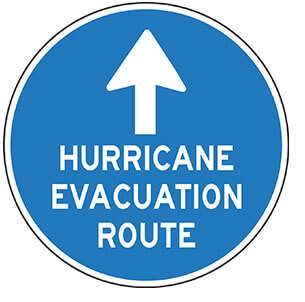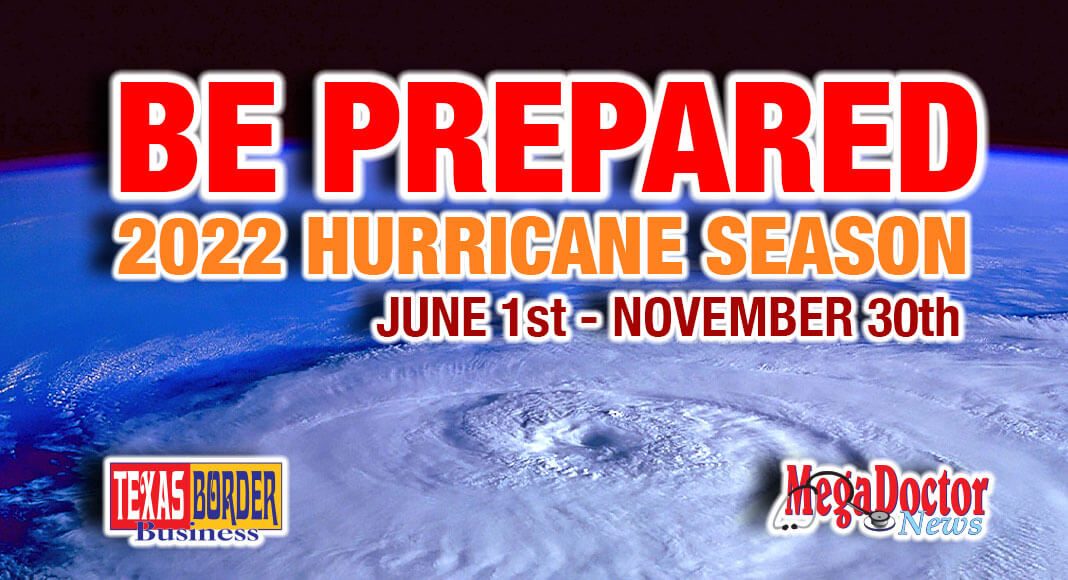
– Download this guide, click here –
– Download Hurricane Tracking Map, click here –
Mgea Doctor News
The 2022 Hurricane season is upon us. The season is from June 1st through November 30th. We have compiled a great deal of helpful information for you and your families during this time. Please take time to read it and be prepared for the worst, and at the same time hope for the best. Never take chances with your life or the lives of your loved ones. If you are told to evacuate, please do so. Do not wait until the last minute. Pay attention to the warnings, be prepared and use common sense when dealing with the forces of nature that could easily turn deadly.
The impact of a major hurricane on Texas coastal communities would be a disaster of significant proportions. It is important for all Texas coastal residents to prepare for these storms in advance. The following is a short listing of guidelines to help you develop a plan to survive a hurricane, minimize losses, and recover once the storm moves away.
Rio Grande Valley Evacuation Routes and Information
When a hurricane threatens the Rio Grande Valley, your county judge may call for a mandatory
west on U.S. Expressway 83 toward Laredo or take U.S. Highway 281 north toward San Antonio. Another alternative is to evacuate to into the interior of Mexico if you are familiar with the roads and/or have family there.
Local radio stations such as KFRQ 94.5 FM, KGBT 98.85 FM, KURV 710 AM and KGBT 1530 AM all broadcast emergency alerts. The phone number for road conditions on state highways is 1-800-452-9292.
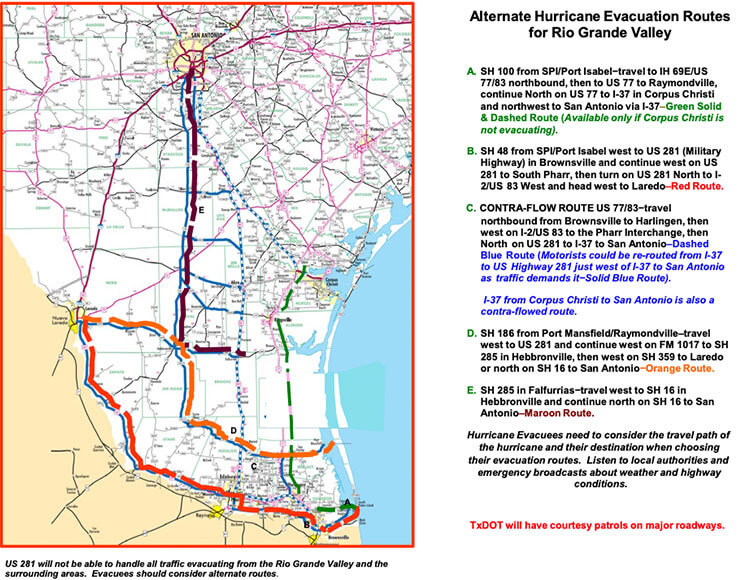
2-1-1 Transportation Assistance Registry
If you live in a hurricane evacuation zone and you have special health care of transportation needs, you may need to make extra efforts to get ready for hurricane season. Hurricane season officially begins June 1 and continues through November 30.
Operators answering phones at 2-1-1 are prepared to help you register for the Transportation Assistance Registry now, before hurricane season begins. If you are interested in registering and you want to find out whether you are living in an evacuation zone, simply dial 2-1-1 from any phone for information.
If there is a hurricane and there is a need to evacuate, is someone going to pick me up or call me to see if I need help?
Emergency planners in your community may or may not have the capacity to make individual phone calls to see if you need assistance evacuating. Do not assume that someone will contact you. Local emergency management will make every attempt to evacuate someone who does not have the ability to evacuate themselves, as long as the person is in the direct path of the storm. In the event of a hurricane entering the Gulf, individuals should pay close attention to local media to determine when and how evacuation will take place. Continue with your individual evacuation plans and call 2-1-1 if you need further guidance.
Information, Tips, and Safety From the National Hurricane Center (NOAA)
| 2022 Storm Names | |||||
| Alex Bonnie Colin Danielle Earl Fiona Gaston Hermine Ian Julia Karl Lisa Martin Nicole Owen Paula Richard Shary Tobias Virginie Walter |
Hurricane Tips
Hurricanes are among nature’s most powerful and destructive phenomena. On average, 12 tropical storms, 6 of which become hurricanes form over the Atlantic Ocean, Caribbean Sea, or Gulf of Mexico during the hurricane season which runs from June 1 to November 30 each year. In the Central Pacific Ocean, an average of 3 tropical storms, 2 of which become hurricanes form or move over the area during the hurricane season, which runs from June 1 to November 30 each year. Guam, the Northern Marianas and Micronesia experience typhoons all year round but the main season in July through November with a peak from mid-August to mid-September. Over a typical 2-year period, the U.S. coastline is struck by an average of 3 hurricanes, 1 of which is classified as a major hurricane (winds of 111 mph or greater). By knowing what actions to take before the hurricane season begins, when a hurricane approaches, and when the storm is in your area, as well as what to do after a hurricane leaves your area, you can increase your chance of survival. If you, or someone you know, have been a victim of a hurricane, please share your story, including the town and state you were in and the year the event took place.. Please note that NS will then have permission to use your story for educational campaigns. Sharing this information may help save someone’s life in the future. Read stories from survivors and learn how to stay safe.
Hurricane Hazards
While hurricanes pose the greatest threat to life and property, tropical storms and depression also can be devastating. The primary hazards from tropical cyclones (which include tropical depressions, tropical storms, and hurricanes) are storm surge flooding, inland flooding from heavy rains, destructive winds, tornadoes, and high surf and rip currents.
- Storm surge is the abnormal rise of water generated by a storm’s winds. This hazard is historically the leading cause of hurricane related deaths in the United States. Storm surge and large battering waves can result in large loss of life and cause massive destruction along the coast.
- Storm surge can travel several miles inland, especially along bays, rivers, and estuaries.
- Flooding from heavy rains is the second leading cause of fatalities from landfalling tropical cyclones. Widespread torrential rains associated with these storms often cause flooding hundreds of miles inland. This flooding can persist for several days after a storm has dissipated.
- Winds from a hurricane can destroy buildings and manufactured homes. Signs, roofing material, and other items left outside can become flying missiles during hurricanes.
- Tornadoes can accompany landfalling tropical cyclones. These tornadoes typically occur in rain bands well away from the center of the storm.
- Dangerous waves produced by a tropical cyclone’s strong winds can pose a significant hazard to coastal residents and mariners. These waves can cause deadly rip currents, significant beach erosion, and damage to structures along the coastline, even when the storm is more than a 1,000 miles offshore.
HURRICANE SAFETY
Review these common terms associated with hurricanes and hurricane safety:
- National Hurricane Center (NHC): The NHC mission is to save lives, mitigate property loss, and improve economic efficiency by issuing watches, warnings, forecasts, and analyses of hazardous tropical weather and by increasing understanding of these hazards. The NHC is responsible for forecasts for Atlantic and eastern Pacific basin tropical cyclones.
- Central Pacific Hurricane Center (CPHC): The CPHC issues tropical cyclone warnings, watches, advisories, discussions, and statements for tropical cyclones between 140 Degrees West Longitude to the International Dateline, which is the region of the Pacific Ocean surrounding Hawaiʻi.
- Eye: The calm, clear center of the storm, which is surrounded by the eyewall. The eyewall is where winds are strongest.
- Direct death: A death that occurs due to hazards from physical forces of a hurricane. Examples include deaths by flooding, flying debris, or collapsing buildings.
- Indirect death: A death that occurs after a hurricane as a result of hurricane damage. Indirect deaths can be hard to count and can happen days, weeks, or even months after a storm passes. Examples include deaths due to power loss, overexertion during cleanup, generator accidents, and water-borne diseases spread by flooding.
- Rip currents: A powerful type of current where water flows away from the shore back towards the sea, cutting through the waves. People are at risk of drowning when the rip current carries them so far offshore that they are unable to get back to the beach. Rip currents and high surf can be deadly, even when storms are hundreds of miles offshore, sometimes days before a hurricane passes. Pay attention to signs on the beach and guidance from local officials and lifeguards.
To learn more about the differences between tropical storms, cyclones, depressions, and other tropical weather, read these definitions.
What is a Hurricane Watch?
Hurricane conditions (sustained winds of 74 mph or greater) are possible somewhere within the specified area.
What is a Hurricane Warning?
Hurricane conditions (sustained winds of 74 mph or greater) are expected somewhere within the specified area. Evacuate immediately if so ordered.
What is a Tropical Storm Watch?
Tropical storm conditions (sustained winds of 39 to 73 mph) are possible somewhere within the specified area within 48 hours.
What is a Tropical Storm Warning?
Tropical storm conditions (sustained winds of 39 to 73 mph) are expected somewhere within the specified area within 36 hours.
What is a Storm Surge Watch?
There is a possibility of life-threatening storm surge flooding from rising water moving inland somewhere within the specified area, generally within 48 hours.
What is a Storm Surge Warning?
There is a danger of life-threatening storm surge flooding from rising water moving inland somewhere within the specified area, generally within 36 hours. If you are under a storm surge warning, check for evacuation orders from your local officials.
Storm Surge
Storm Surge is an extremely dangerous hazard associated with hurricanes and tropical storms. Storm surge happens when wind from a storm drives water onshore, causing an unusual and rapid rise in water level. Larger, stronger storms typically produce the greatest storm surge flooding. Storm surge occurs in addition to the normal tides, so coastal storm surge flooding is worst during high tide.
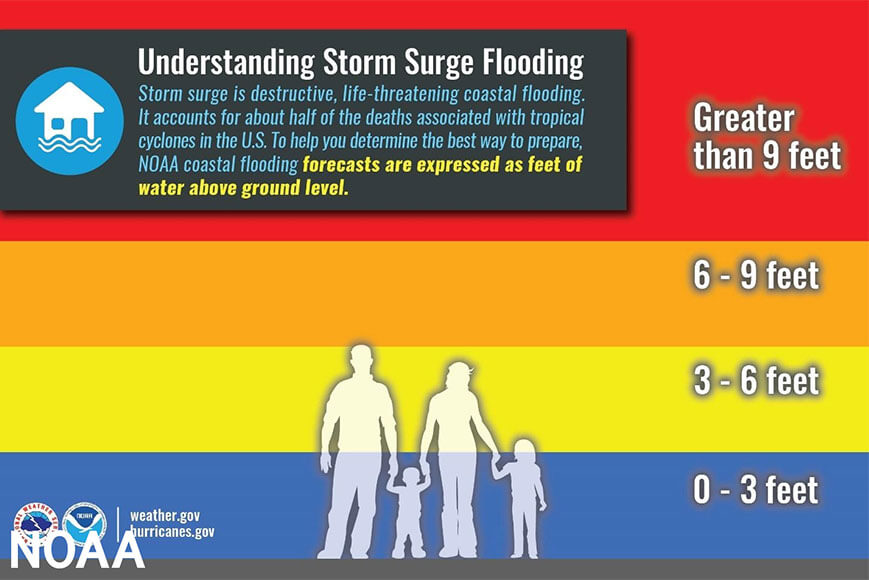
The deadliest natural disaster in American history was the hurricane that hit Galveston, Texas, in 1900. More than 8,000 people died during the hurricane, which had a 15-foot storm surge, in a city where the highest point was less than nine feet above sea level. This means that even in the highest areas of the city, water was around 6 feet deep. Other hurricanes with high death tolls, like Sandy in 2012, Katrina in 2005, and Camille in 1969, all had large numbers of deaths from storm surge. Historically about half of the direct deathsoffsite link in landfalling tropical cyclones in the United States are from storm surge.
Protect yourself from storm surge
Always follow guidance and evacuation orders from local emergency managers.
With improvements in forecasting and storm surge warnings from the NWS, and better ways emergency managers can reach vulnerable residents, more people can evacuate ahead of a storm, saving lives. Hurricane Laura (2020) produced an “unsurvivable” storm surge, but early warnings and forecasts and the resulting evacuations helped save countless lives. There were no known deaths from the 12-18 foot storm surge during this storm, which was a comparable surge to the 1900 Galveston, Texas surge.
Learn your risk for storm surge and review the National Hurricane Center storm surge hazard maps.
These maps can help you find out if you live in an area vulnerable to storm surge. Storm surge can reach many miles from a coast in low-lying areas. Rivers far inland from the ocean can also be subject to storm surge. If you live in an area prone to storm surge, you can also check with your local emergency managers to find out your evacuation zone and where the evacuation shelters are located.
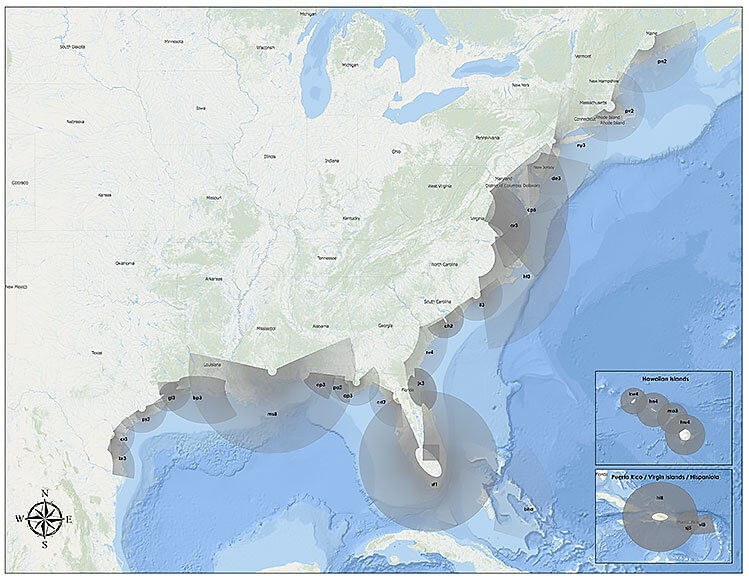
Heavy rainfall
If you can see a body of water while on flat ground, you’re too close
Hurricanes can bring tremendous amounts of rain. While a typical heavy thunderstorm may bring a few inches, some hurricanes can dump several feet of rain on an area. Rain from a tropical system can reach hundreds of miles inland, and flood warnings may occur very far from the eye of a storm. Along the Gulf of Mexico and eastern United States, rainfall from hurricanes makes up 10-15% of the total annual rainfall.
Slow-moving storms, like Hurricane Florence (2018), Hurricane Harvey (2017) and Tropical Storm Allison(2001), can dump an enormous amount of rain on one area — on rare occasions 30 or more inches over the course of one storm. Always listen to local emergency managers and follow evacuation orders when issued.
Any body of water — a lake, river, stream, or pond, including ones that are far inland — is at risk of flooding during a hurricane or tropical storm. The ground may already be saturated with water if there has been heavy rains before the hurricane, meaning an even higher likelihood of flooding. In general, if you are on flat ground and you can see a body of water during a hurricane, you are too close to it. If you live in an area prone to flooding, you may need to evacuate — this may be only a few miles or quite far, depending on the local conditions. The purpose of an evacuation order is to get you safely to a place that is at low risk of flooding.
Flooding can still be a major hazard weeks after a hurricane passes, even when evacuation orders may have expired and wind is no longer a threat. This can be especially true in areas near rivers that are downstream from where hurricanes make landfall. Dams must release the excess water from hurricane rains, which can result in flooded downstream rivers with strong and dangerous currents weeks after a hurricane.
Protect yourself from flooding and rain-related hazards
Always keep a safe distance from flooded and damaged areas. Never drive through floodwaters or compromised bridges. Always pay attention to barriers and signage. If you encounter flooding, remember: Turn Around Don’t Drown. Downstream flooding can lead to many indirect deaths following a hurricane. Learn about land and mudslide risks and how to prepare for them.
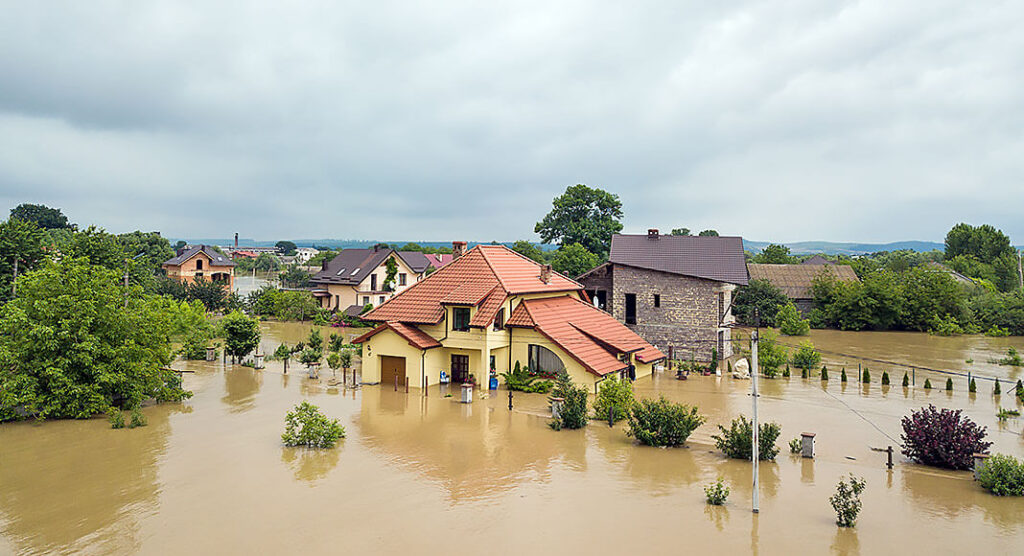
Strong wind
Put as many walls as possible between you and the outside
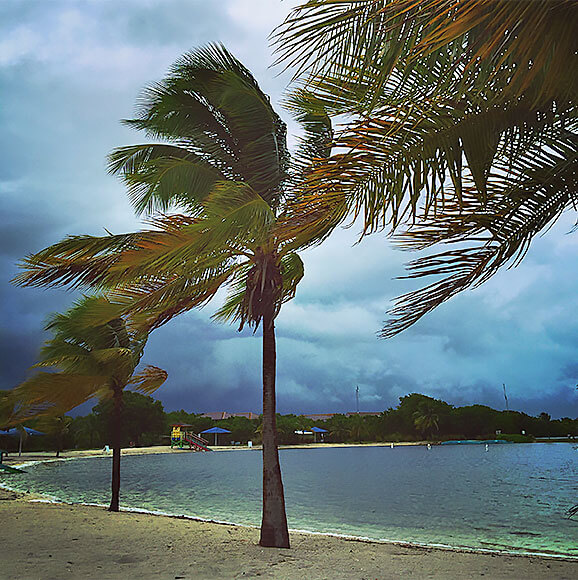
Though rain and storm surge cause more direct deaths, wind can also be very destructive and deadly in hurricanes. Hurricane categories are based solely on wind speed. Category 5 storms have the fastest wind speeds at 157 mph or higher. When Hurricane Andrew struck Miami in 1992, the National Hurricane Center (NHC) was along its path. The NHC recorded a gust of wind at 164 mph atop their building, and wind gusts in the eyewall may have reached as high as 200 mph! At speeds this high, wind can lift cars in the air, flatten houses, and cause catastrophic damage.
Always pay attention to the latest forecast as conditions can change quickly and storms can rapidly intensify from a tropical storm to a major hurricane. And always follow evacuation orders from local authorities — don’t wait for a hurricane to intensify before deciding to follow the order. If a storm rapidly intensifies just before landfall, like the 1935 Labor Day hurricane and many others did, there can be catastrophic damage from the wind and storm surge.
All of the most powerful hurricanes to make landfall in the U.S. were tropical storms three days before landfall. Each storm rapidly intensified to a major hurricane in three days. Always listen to the most recent hurricane forecasts as they can change quickly! (National Weather Service/Dan Brown)
Winds can be stronger higher above ground level. This can put high-rise buildings at a greater risk. High elevations, like mountains, can also be at a greater risk of wind damage. This can be the case in the Appalachian mountain region and can be especially dangerous in the Caribbean, where mountains are much closer to the shore. Hurricane Hugo (1989), which made landfall as a category 4 near Charleston, South Carolina, moved quickly across the Carolinas, eventually leading to damage well inland in the Carolinas, and even in the mountainous areas of the southern Appalachians.
Protect yourself from the wind
To protect yourself from wind, the best thing you can do is put as many walls as possible between you and the outside. An interior room without windows is the safest place you can be in a building. Reinforcing windows and doors can help you stay safe inside, while securing outdoor items and trimming trees can help minimize damage. If you find yourself stuck in a storm, head to an interior room without windows. You can cover yourself with a mattress and wear a helmet for added protection.
Strong winds from tropical storms and hurricanes can cause rip currents.
Rip currents and high surf can be deadly, even when storms are hundreds of miles offshore, sometimes days before a hurricane makes landfall. Do not travel to the beach to surf, swim, or loiter. Pay attention to signs on the beach and guidance from local officials and lifeguards.
There are specific actions you can take before, during, and after a hurricane to help protect your life and property. Some preparations can be made any time of the year, including today! Are you ready?
Before
These steps will help you prepare for the hazards of a hurricane.
- Determine your risk. Most importantly, you need to know what your local hazards are. Find out if you live in an evacuation zone so you are ready to follow evacuation orders. Learn whether storm surge is a risk in your area (even if you are inland).
- Develop an evacuation plan. If you live in an evacuation zone, determine how you will evacuate and where you will go if an evacuation order is issued. How will you get to your destination? Be sure to plan an alternate route! How can you take care of your pets? You don’t necessarily need to travel hundreds of miles to be safe, but always make sure your evacuation destination provides protection from hurricane hazards, like inland flooding near a river, creek, or dam or mudslides.
- Assemble disaster supplies. Devastating hurricanes can lead to long recovery times. Be prepared with at least three days of supplies (or more!) including water, non-perishable food, medicine, and pet supplies. Extra cash, a battery-powered radio, flashlights, and a portable crank or solar powered USB charger to charge your cell phone are also important. These supplies are helpful in any disaster, not just a hurricane, so it is always a good idea to have them on hand.
- Get an insurance checkup. Check with your insurance agency before hurricane season to learn what is covered. Flood insurance requires a separate policy for both owners and renters. Learn more about the National Flood Insurance Program.
- Strengthen your home. You can take steps to make your home more resilient to threats from a hurricane. Purchase plywood, steel, or aluminum panels to board up windows and doors and have them on hand. Keep your trees trimmed. Secure loose outdoor items and furniture and find a safe place for your car.
- Learn how to help your neighbor. Get to know your neighbors and their needs. Many people, especially senior citizens, may need help from neighbors before, during, and after hurricanes.
- Write down your plan. Once you have made all of these preparations, write them down! It’s easy to forget something you planned far in advance. Store your written plan somewhere safe, have photo documentation of valuables, and share your plan with your family.
During
As a hurricane approaches, always pay attention to local emergency managers. Follow evacuation orders when they are issued. Help is scarce during and following a hurricane, so preparation for and awareness of evacuation orders is key.
If your local area is under a hurricane warning:
- Be prepared to shelter in an interior portion of your home. Get as far away from windows and doors as possible. The more walls you can put between you and the outside, the better.
- Never go outside during the calm period when the eye of the storm passes. The eyewall is the most dangerous part of a hurricane and can come on suddenly.
- Stay out of flooded areas. Just six inches of water can knock an adult off their feet and flood waters can carry disease.
- Keep your battery-operated radio and a flashlight or camping lantern nearby. You will need them!
After
There are many hazards that follow a hurricane that can lead to indirect deaths or injuries.
- Overexertion is especially dangerous. Following a hurricane, people may want to clean up immediately, but overexertion can lead to heart attacks, heat strokes, and other serious medical issues. Perform cleanups safely and slowly. Be sure to take lots of breaks and not push beyond your limits.
- Generator accidents are very common following a hurricane that caused power outages. Familiarize yourself with generator safety if you think you may use one. Carbon monoxide poisoning, electric shock, and fire are the most common hazards,
- Power tools, like chainsaws, that are used during cleanup can lead to accidents and death. If you are not trained to use them, leave the power tools to the experts.
- Flooded roads are very dangerous. It can be difficult to judge how deep or swift the water is moving — just 12 inches of water can float a car. Never drive through flooded roads, even if you are seeking supplies or trying to check on someone. Floods can also compromise bridges and roads. Avoid flooded river areas, as they can continue to rise long after a storm passes.
Develop an Evacuation Plan
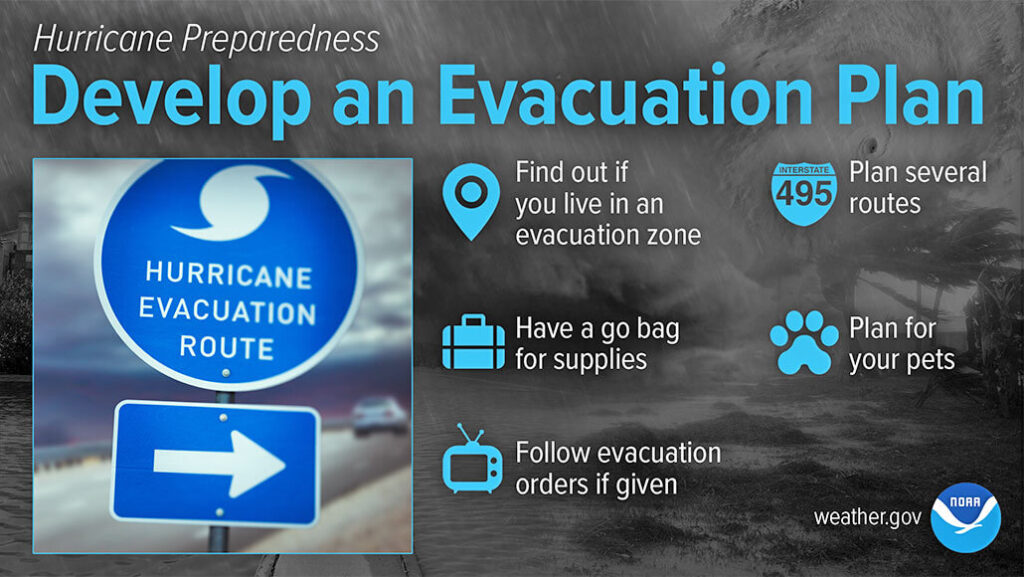
Find out if you live in a hurricane evacuation zone. You may also need to leave if you live in a flood prone area or in a mobile home outside a hurricane evacuation zone. Now is the time to begin planning where you would go and how you would get there.
You do not need to travel hundreds of miles. Your destination could be a friend or relative who lives in a well-built home outside flood prone areas. Remember, your safest place may be to remain home. Be sure to account for your pets in your plan.
As hurricane season approaches, listen to local officials on questions related to how you may need to adjust any evacuation plans based on the latest health and safety guidelines from the CDC and your local officials.
Assemble Disaster Supplies
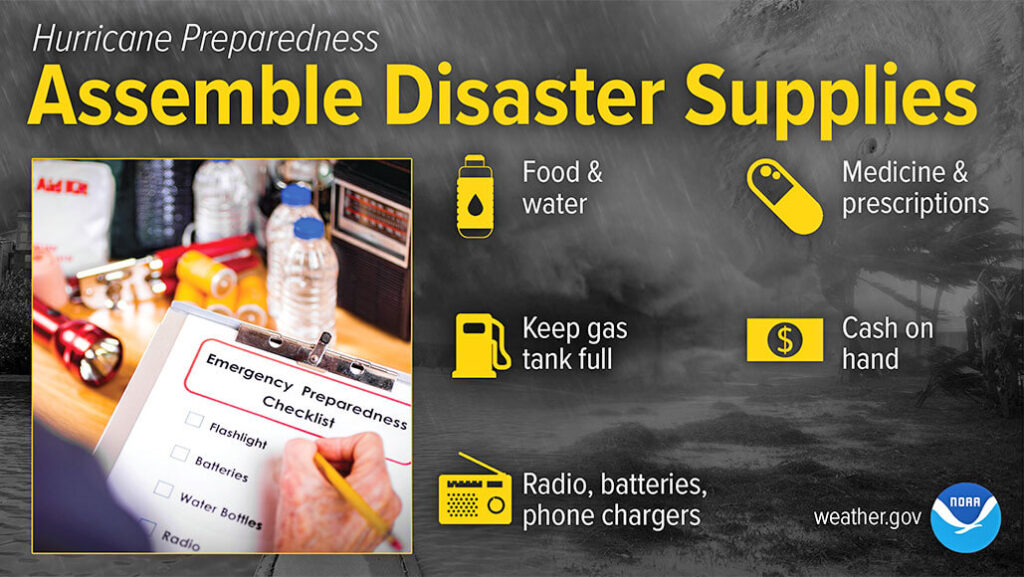
Whether you’re evacuating or sheltering-in-place, you’re going to need supplies not just to get through the storm but for the potentially lengthy and unpleasant aftermath. Have enough non-perishable food, water and medicine to last each person in your family a minimum of 3 days (store a longer than 3-day supply of water, if possible). Electricity and water could be out for at least that long. You’ll need extra cash, a battery-powered radio and flashlights. You may need a portable crank or solar-powered USB charger for your cell phones.
If you need to go to a public shelter, follow health guidelines from your local officials and the CDC.
Get An Insurance Checkup
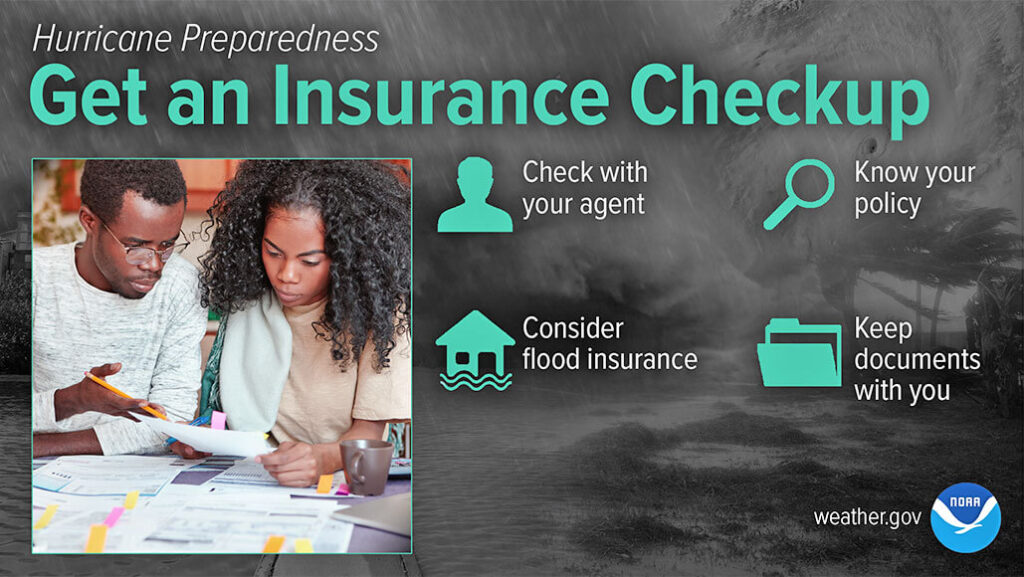
Call your insurance company or agent and ask for an insurance check-up to make sure you have enough insurance to repair or even replace your home and/or belongings. Remember, home and renters insurance doesn’t cover flooding, so you’ll need a separate policy for it.
Flood insurance is available through your company, agent, or the National Flood Insurance Program at floodsmart.gov. Act now, as flood insurance requires a 30-day waiting period.
- FLASH Insurance Guide: If Disaster Strikes, Will You Be Covered?
- Find available coverage at floodsmart.gov
Strengthen Your Home
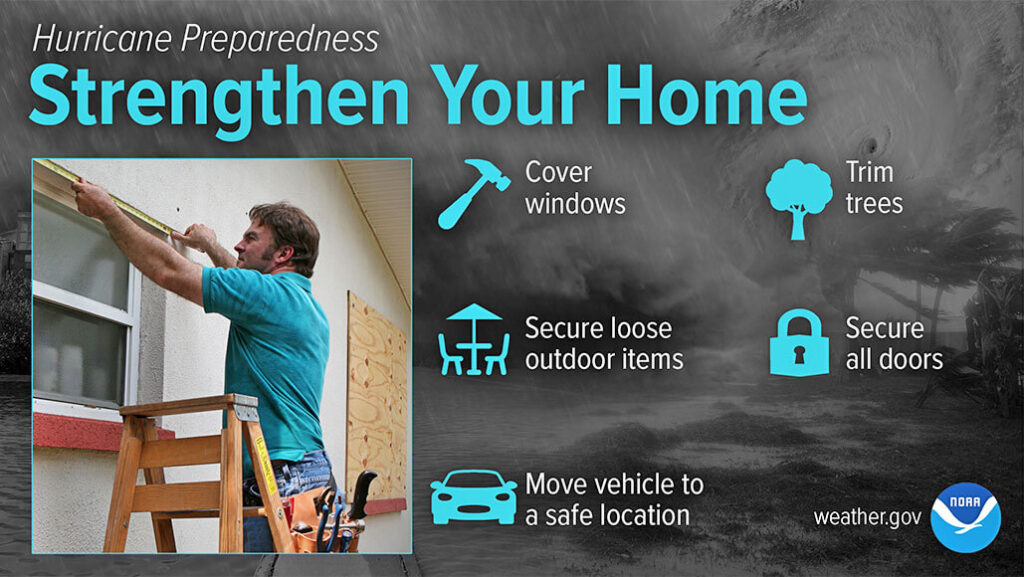
Whether you’re evacuating or planning to ride out the storm in your home, make sure it is in good repair and up to local hurricane building code specifications to withstand wind impacts. Many retrofits are not as costly or time consuming as you may think.
Have the proper plywood, steel or aluminum panels to board up the windows and doors. Remember, the garage door is the most vulnerable part of the home, so it must be able to withstand the winds.
If you’re a renter, work with your landlord now to prepare your home for a storm.
- FLASH: How-To Videos
- Protect Your Home From Flooding Video (English/Spanish)
Help Your Neighbor
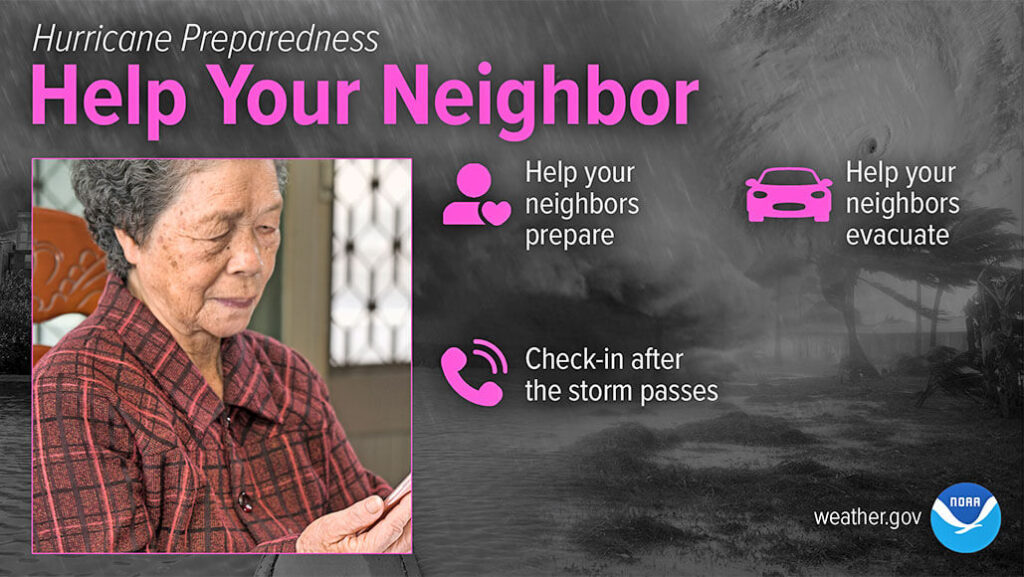
Many people rely on their neighbors before and after a disaster, and there are many ways you can help them. Learn about all the different actions you and your neighbors can take to prepare and recover from the hazards associated with hurricanes.
Start the conversation now with these Neighbor Helping Neighbor strategies but remember you may need to adjust your preparedness plans based on the latest health and safety guidelines from the CDC and your local officials.
Complete A Written Plan
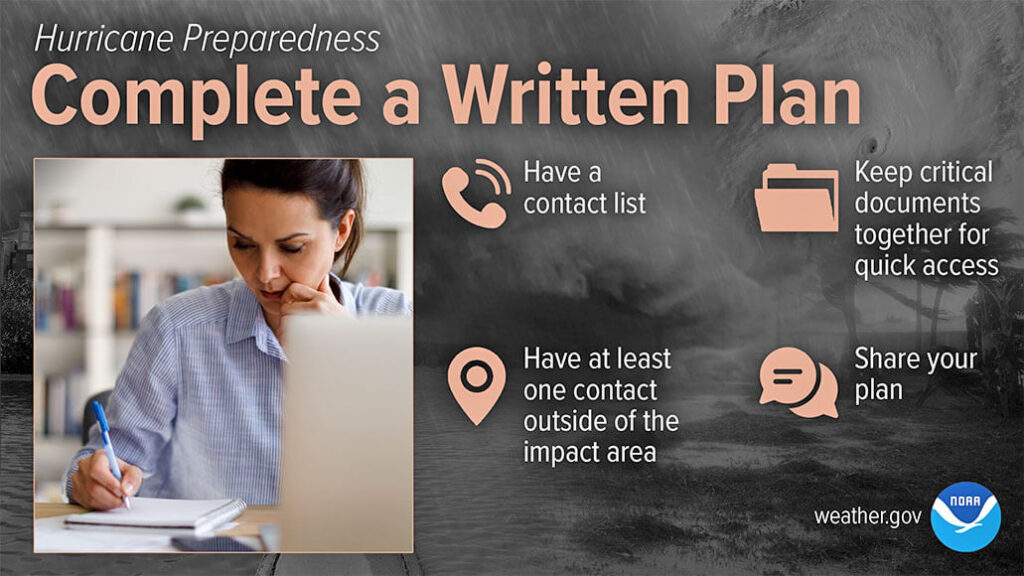
NOAA Image
The time to prepare for a hurricane is before the season begins, when you have the time and are not under pressure. If you wait until a hurricane is on your doorstep, the odds are that you will be under duress and will make the wrong decisions.
Take the time now to write down your hurricane plan. Know who issues evacuation orders for your area, determine locations on where you will ride out the storm, and start to get your supplies now. Being prepared before a hurricane threatens makes you resilient to the hurricane impacts of wind and water. It will mean the difference between being a hurricane victim or a hurricane survivor.
Below are some very helpful videos form NOAA that will help you prepare for the season:
All information was compiled from https://www.nhc.noaa.gov and https://www.hidalgocounty.us






